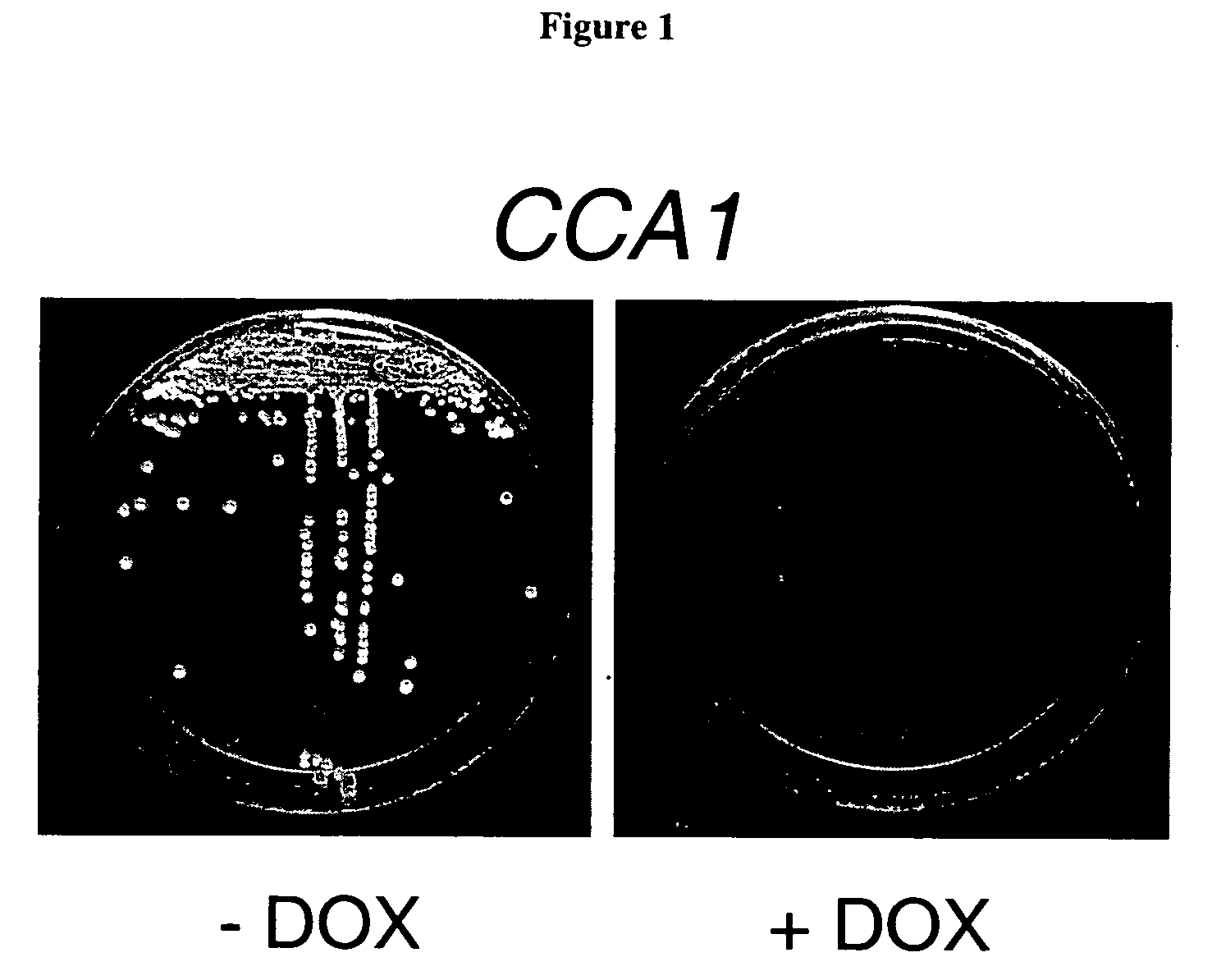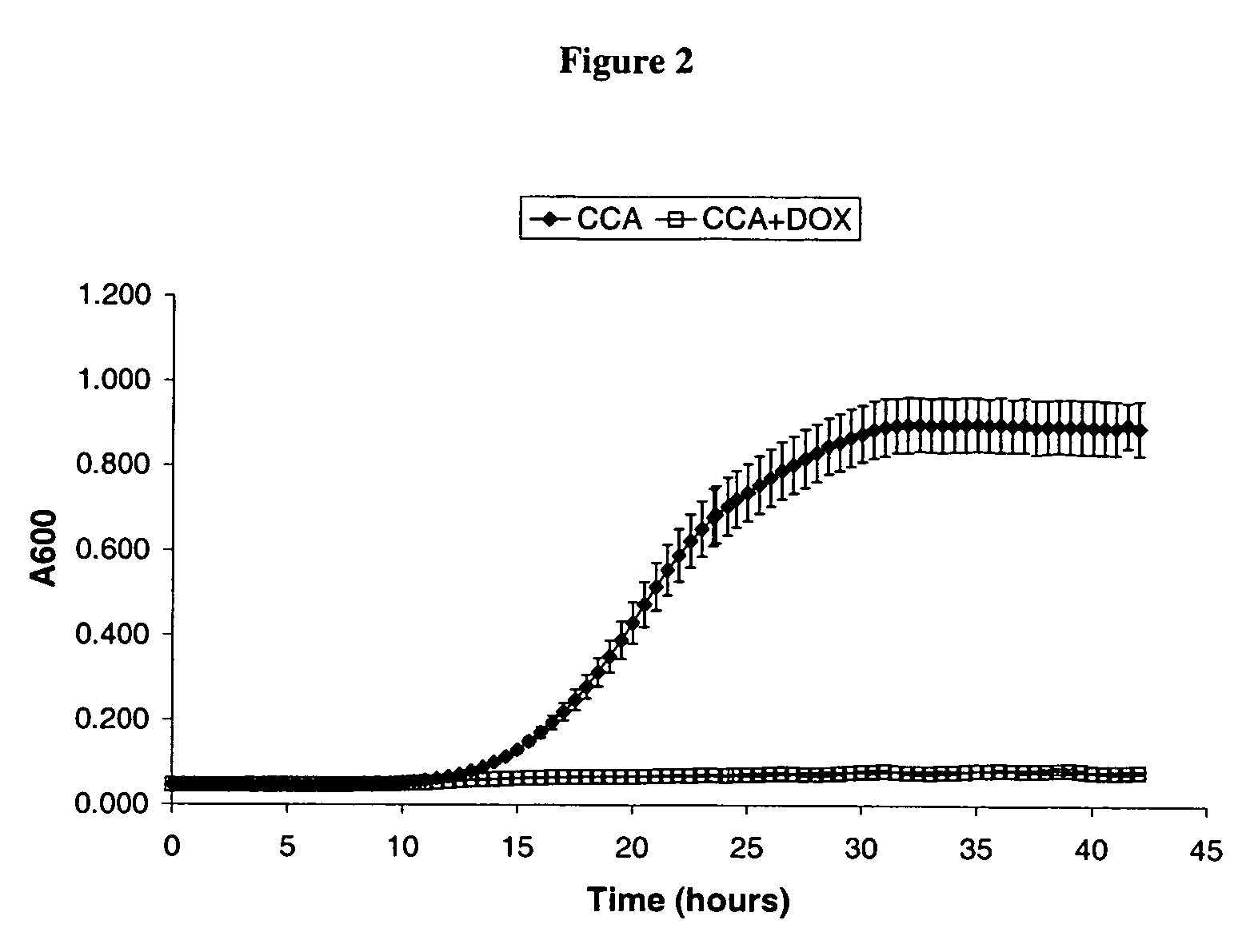Cca1 as an antifungal target
a technology of antifungal target and target, which is applied in the field of new antifungal target, can solve the problems of limited treatment options, misleading and restrictive variation in the art, and increasing financial and logistic burden on the medical care system and its providers, and achieves the effect of inhibiting the function of the fungal trna nucleotidyltransferase and facilitating drug discovery
- Summary
- Abstract
- Description
- Claims
- Application Information
AI Technical Summary
Benefits of technology
Problems solved by technology
Method used
Image
Examples
example 1
Expression of CCA1
[0089] The CCA1 ORF was cloned into pGex-6P-1 (Pharmacia-Biotech) to enable expression as a 5′ GST fusion protein. Host E. coli used were BLR(DE3)pLysS (Novagen). E. coli harbouring the expression plasmid were grown at 30° C. to mid log phase (OD600=0.6) and induced with IPTG (0.3 mM) for approximately 4 h.
example 2
Purification of CCA1
[0090]E. coli BLR cells from 10L of culture were harvested by centrifugation at 6000×g for 10 min. The cell pellets were frozen at −80° C., thawed and resuspended in 150 ml of buffer A (20 mM Hepes (pH7.4), 5 mM DTT, 140 mM NaCl, 1 mM EDTA, 10% (v / v) glycerol, 0.02% (w / v) sodium azide, and a protease inhibitor cocktail consisting of 1 mM benzamidine, 1 mg.ml−1 each of pepstatin, antipain and leupeptin, 0.2 mM PMSF, Complete (Roche) and general protease inhibitor cocktail (Sigma).
[0091] The extract was sonicated in 3×10 s bursts to reduce viscosity. Triton X-100 was added to 1% followed by centrifugation at 100 000×g for 15 min. The supernatant was diluted to 400 ml with buffer A and was applied to a 5 ml glutathione Sepharose column linked to an AKTA FPLC system (Amersham Biosciences). The column was extensively washed with buffer B (20 mM Hepes (pH 7.4), 1 mM DTT, 1 mM EDTA, 10% glycerol, 0.02% sodium azide) containing 0.5M NaCl, then with buffer B. GST-CCA1 w...
example 3
CCA1 Assay
[0093] 3.1 Preparation of the tRNA substrate
[0094] The tRNA substrate was prepared according to the method of Zubay and Takanami (1964) (Zubay G, & Takanami M, 1964, Biochem. Biophys. Res. Commun., March 26, 15:3, 207-13). The 3′-ends of the tRNA were trimmed to allow the addition of both CTP and ATP by CCA1. In brief, 100 mg tRNA (Sigma, grade XXI) was incubated for 1 h at 20° C. in 25 ml 100 mM Tris-HCl pH 9.0 containing 1.2 units snake venom phosphodiesterase I. The reaction was stopped by means of a phenol:chloroform extraction and rRNA fragments and degradation products removed by binding tRNA to Q-Sepharose in 20 mM Tris-HCl pH 7.5 (2 mg of tRNA / ml column; Amersham Pharmacia Biotech). The column was washed with. 0.4M NaCl, 20 mM Tris-HCl pH 7.5 and the tRNA eluted with a 0.4-1.OM NaCl gradient. Following ethanol precipitation, the pooled tRNA fractions were resuspended in water and adjusted to 1 mg / ml final concentration.
[0095] 3.2 Assay Conditions
[0096] The ATP(...
PUM
 Login to View More
Login to View More Abstract
Description
Claims
Application Information
 Login to View More
Login to View More - R&D
- Intellectual Property
- Life Sciences
- Materials
- Tech Scout
- Unparalleled Data Quality
- Higher Quality Content
- 60% Fewer Hallucinations
Browse by: Latest US Patents, China's latest patents, Technical Efficacy Thesaurus, Application Domain, Technology Topic, Popular Technical Reports.
© 2025 PatSnap. All rights reserved.Legal|Privacy policy|Modern Slavery Act Transparency Statement|Sitemap|About US| Contact US: help@patsnap.com


